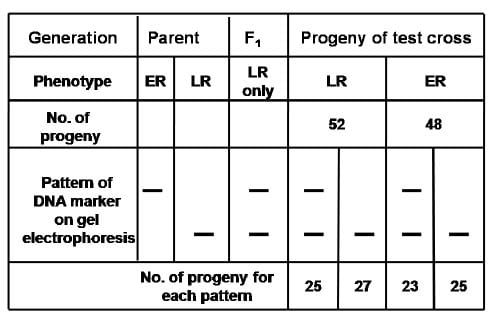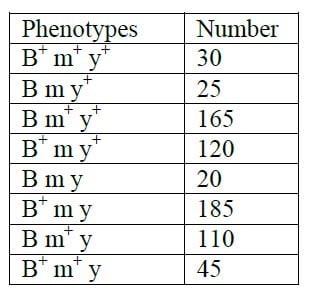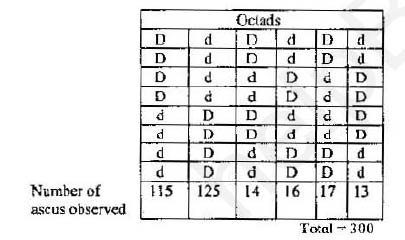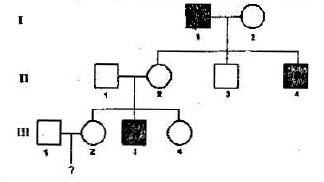Dear Students,
Welcome to Genetics MCQ-10 (Genetics CSIR NET Part-2). This MCQ set consists of Advanced (PG Level) Genetics and Molecular Genetics Multiple Choice Questions taken from the previous year question papers of CSIR NET Life Sciences Examination. These questions can be used for the preparation of Competitive examinations in Biology / Life Sciences such as CSIR JRF NET, ICMR JRF, DBT BET JRF, GATE and other University Ph.D Entrance Examinations. After marking your answers, please click ‘SUBMIT‘ button to see your ‘SCORE‘ and ‘CORRECT ANSWERS‘.
You may also like: Genetics Notes | Genetics PPT
(1). Two mutant plants, both bearing white flowers, were crossed. All F1 plants had red coloured flowers. When an F1 plant was selfed it produced progeny with either red or white coloured flowers in 9:7 ratio. Based on this information, which one of the following conclusions is correct?
(a). The mutations in the parents do not complement each other
(b). The mutations in the parents are allelic
(c). The mutations in the parents are nonallelic
(d). The mutations in the parents are linked
Ans. (c)
(2). A new mutant called early ripening (EL) is identified in a plant. The wild type phenotype is late ripening (LR). Further DNA marker(s) is/are observed to be polymorphic between EL and LR plants. A cross was made between pure lines of LR and ER. The F1 progeny was test crossed and its progeny was analyzed. The parental, F1 and progeny of test cross were also analyzed for the DNA marker. The table below summarizes the phenotype of the progeny and the pattern of DNA marker observed in each case:

Based on the above information, the following statements were made:
(A). LR is dominant to ER
(B). The DNA marker used is a dominant marker
(C). The DNA marker is linked to the phenotype
Which of the above statements are correct?
(a). A only
(b). A and B only
(c). A and C only
(d). A, B and C only
Ans. (a)
(3). In Drosophila, Bar eye (B) is a dominant mutation while miniature wing (m) and yellow body colour (y) are recessive mutations. Heterozygous females for these mutations were crossed to normal eyed miniature winged and yellow body coloured males. Assume the following progeny was obtained:

Based on the results obtained, the order of genes will be:
A. B m y
B. m B y
The genetic distance between B and y will be:
C. 40 cM
D. 17.1cM
The correct combination of answer is:
(a). A and C
(b). B and C
(c). A and D
(d). B and D
Ans. (b)
(4). Two inbred lines of beans were intercrossed. In F1 the variance in bean length was measured as 2.0. The F1 was selfed to obtain F2 and the variance in bean length in F2 was 7.0. The broad heritability of bean length in the F2 population will be:
(a). 0.75
(b). 9.0
(c). 5.0
(d). 0.71
Ans. (d)
(5). The following table summarizes the result of a cross between two strains of Neurospora having the alleles D and d, respectively. The table shows the different patterns of octad arrangement and the number of ascus observed of each type.

Based on the above, fill in the blanks from the options given below,
“The first two columns are from meiosis with no crossover between locus D and [A]. The pattern for these two columns represent [B] segregation pattern. The distance between the locus D and the centromere is [C] map units”:
(a). [A]. d allele; [B]. First division; [C]. 10
(b). [A]. centromere; [B]. First division; [C]. 10
(c). [A]. d allele; [B]. Second division; [C]. 20
(d). [A]. Centromere; [B]. Second division; [C]. 10
Ans. (b)
All the questions were taken from the CSIR JRF NET Life Sciences Examination
(6). The inheritance pattern of a common trait which shows complete penetrance is shown below:

Based on the above pedigree, fill in the blanks from the options given below:
“The trait is [A]. The probability that a child from the marriage of individuals III-1 and III-2 will show the trait is [B], considering that the individual III-1 is a carrier of the trait”
(a). [A]. Y-linked; [B]. 0
(b). [A]. Y=linked; [B]. 1/2
(c). [A]. Autosomal; [B]. 1/8
(d). [A]. Autosomal; [B]. 1/6
Ans. (c)
(7). Which one of the following statements is INCORRECT?
(a). Quantitative inheritance results in a range of measurable phenotypes for a polygenic trait.
(b). Polygenic traits often demonstrate continuous variation.
(c). Certain alleles of quantitative trait loci (QTL) have an additive effect on the character/trait.
(d). Alleles governing quantitative traits do not segregate and assort independently.
Ans. (d)
(8). A mouse carrying two alleles of insulin-like growth factor II (IgF2) is normal in size; whereas a mouse that carries two mutant alleles lacking the growth factor is dwarf. The size of a heterozygous mouse carrying one normal and one mutant allele depends on the parental origin of the wild type allele. Such pattern of inheritance is known as:
(a). Sex-linked inheritance
(b). Genomic imprinting
(c). Gene-environment interaction
(d). Cytoplasm inheritance
Ans. (b)
(9). Which one of the following statements is INCORRECT?
(a). Loss of genetic variation occurs within a small population due to genetic drift.
(b). The number of deleterious alleles present in the gene pool of a population is called the genetic load.
(c). Genetic erosion is a reduction in levels of homozygosity.
(d). Inbreeding depression results from increased homozygosity for deleterious alleles.
Ans. (c)
(10). What is the genotype of a male Drosophila fly that has yellow body colour and red eyes. Brown (y+) is dominant over yellow (y) and red (w+) is dominant over white (w). Both are carried on X chromosome.
(a). X^w+y Y
(b). X^wyY
(c). X^wy+Y
(d). X^wy+X^wy+Y
Ans. (a)
You may also like...
NOTES QUESTION BANK COMPETITIVE EXAMS.
PPTs UNIVERSITY EXAMS DIFFERENCE BETWEEN..
MCQs PLUS ONE BIOLOGY NEWS & JOBS
MOCK TESTS PLUS TWO BIOLOGY PRACTICAL

The Correct answer of question No 5 Will be option B please Correct it
Thank you very much Paul sir,
The correction is incorporated.
Regards
EBC